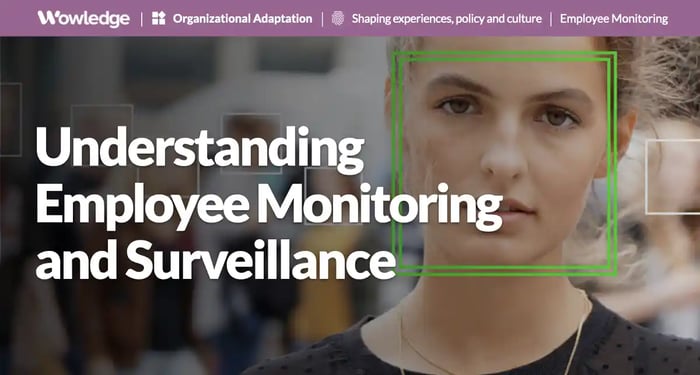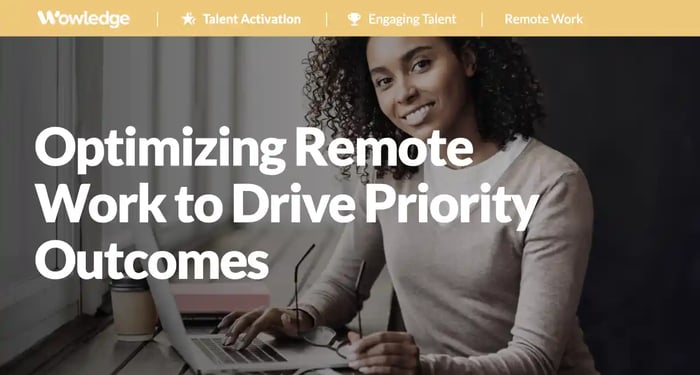Table of Contents
- The prevalence of employee monitoring and surveillance
- Forms of monitoring and surveillance
- Employee Surveillance vs. Monitoring
- Legal considerations with employee monitoring
- Talent-related issues and downsides to manage
- Managing the issue is one of balance
- Effectively managing the use of employee monitoring
- Relevant Practices & Tools
- About Wowledge
Employee monitoring and surveillance have become a hot topic in the past several years, mainly due to the widespread adoption of remote or work-from-home policies implemented during the pandemic. Its continuing use with updated remote and hybrid work policies may seem new to many. However, employee surveillance and monitoring have a history that predates the Industrial Revolution and has only become a more pervasive and controversial practice due to their use with white-collar knowledge workers.
What initially started as an effort to understand and reduce manufacturing workers' 'wasted' time. employee monitoring and surveillance have transformed into a technologically driven industry. Today, various software tools are available and deployed to monitor employee work, including keystrokes, app usage, email and collaboration platform communications, and even physical movements and physiological states.
The challenges that organizations and their employees face in the context of employee monitoring and surveillance are significant. However, they also underscore the importance of developing constructive policies, practices, and uses that align with solid employee relations, productivity, and engagement considerations. This emphasis on ethical and respectful monitoring is not just a necessity but a commitment to maintaining a healthy and productive work environment.
The prevalence of employee monitoring and surveillance
For over a hundred years, employee monitoring and surveillance have existed in high-volume workplaces such as manufacturing operations. It has grown substantially due to the adoption of automated manufacturing, centralized call center management, enterprise email systems, and GPS systems, which accelerated the ability of organizations to monitor individual and process work efforts. These are commonplace and expected from employees in repetitive transaction jobs and industry segments such as manufacturing, warehousing, shipping and distribution, call centers, and hospitals. In this digital age, however, employee surveillance and monitoring have been extended to white-collar workers, creating anguish and backlash.
Driven by the sudden and rapid adoption of remote work in 2020, the trend is increasing significantly. Gartner reports that 60% of large employers use these to monitor their employees, twice the rate before the pandemic. This number will increase to 70% or more in the coming years. Security Magazine reports 73% global growth in digital monitoring, and corporate spending on employee monitoring is projected to hit $6.9 billion by 2030.
Numerous studies have shed light on the preponderance of workplace monitoring with remote and hybrid workers, with one finding that 78% of companies are using such software to track their offsite workers' individual performance and online activity. Even with more workers returning to the office on a hybrid or full-time basis, these technologies continue, with 90% of those companies reporting the tracking of hours worked and those spent in non-work activities. They further acknowledge that the scrutiny is being used as data in performance assessment, with 73% saying that stored recordings of staff calls, emails, or messages informed employee performance reviews and 46% who reported firing a remote employee based on such information.

Forms of monitoring and surveillance
The range of employee monitoring and surveillance activities is broad, but they tend to fall into two distinct categories: observation and digital. Observation is the traditional form that began when people started having their work efforts overseen by others. Digital has become prevalent in the modern world, given the volume of knowledge workers using technological tools and systems to conduct their work.
Observation
In the current world, employee monitoring and surveillance are performed directly or indirectly, depending on who is doing the direct observation and who is responsible for the output or performance of the observed worker. Two types of observational monitoring typically operate in different industries and operational environments. Direct observation occurs when a construction site manager can observe a group of carpenters doing their work and inspect their output as soon as it is produced. Indirect observation happens when a co-worker, project manager, customer, supplier, or other watches the performance and then supplies feedback to the manager, such as informal, solicited, or formal multi-rater feedback. The use of closed circuit TV (CCTV) monitoring by security, safety, or other oversight teams is also considered a form of indirect observation that can be shared with the responsible manager.
Digital
With the preponderance of knowledge workers, digital employee monitoring and surveillance have taken the front seat due to their ability to leverage non-human interaction to collect, process, and summarize patterns of end-user behaviors. The variety of ways to monitor employee behavior on the job is substantial, with available technologies covering the gamut of human-machine interactions. The primary methods include the measurement and tracking of:
Attendance and hours. The use of key or ID card swipes to get in and out of buildings and workspaces, time clocks that scan employee fingerprints to clock them in and out, and hardware-based (desktop, laptop, tablet, and smartphone) activity tracking (outlined further below).
Online activity. Forbes reported that 40% of its surveyed companies employ some active online hours tracking. Various techniques are used to monitor online activity, with programs available to record keystrokes (keylogging) and mouse movements to record and analyze time spent, content sent, and responses for subsequent trend analysis. This also includes:
- Website/app tracking to observe the time of day, duration, and interaction with work- vs. non-work-related website interactions. Research indicates that 42% of workers report monitoring the websites they visit, 31% state that they are subject to real-time screen monitoring, and another 20% report that their organizations capture screen images periodically throughout their work day.
- Video surveillance is used to track employee behavior during their work shifts (such as in CCTV) or during virtual online work sessions and meetings to assess the extent to which they are paying attention by accessing their webcams to collect data on their eye movements and facial expressions.
- File access monitoring provides insights into the databases, knowledge management platforms, and shared or collaborative (e.g., project) files that employees access. 27% of surveyed employees report this type of tracking.
Calls, meetings, chats, and messaging content. Available software can capture and analyze employee activity on company communication and sharing platforms. 32% of the workforce states that their organization records phone calls, meetings, emails, chats, and messaging logs. Another 31% experience checks on their inbound and outbound communications, and 21% state that their calls are transcribed. Data on an employee’s phone use, such as the time of day, call duration, tone of voice, and whether they call an internal (employee) or external (home) number, can be used to track productive vs. unproductive time or provide insights into employee engagement levels.
GPS. This is most commonly used in shipping and distribution-based industries and provides data on an employee’s location, the efficiency of routes, and their location to assess and track their safety and the security of transportation behaviors, goods movement/location, etc. It can also track employee work location and duration within and across designated worksites.
Biometric data. This data type is emerging as a support to the “Internet of Things” (IoT) capabilities that enable secure location access and computer logins, timekeeping systems, and tracking of employee activity, productivity, stress, and physical wellness levels. It is considered highly valuable in secure (e.g., government or military) and remote or dangerous (oil rigs, nuclear plants, logging) worksites.
Employee Surveillance vs. Monitoring
If all this sounds dystopian, using all or many of these in any organization might feel like it is. However, keep in mind that the use of any of these types of monitoring tactics needs to be looked at in context. GPS, for example, has been shown to help make delivery drivers more efficient in their routing while attempting to optimize their productivity and avoid traffic jams, road construction, or difficult parking situations while making drop-offs. Tracking employee file access has been critical to safeguarding vital military secrets and other national interest resources.
While employee monitoring and surveillance are similar management practices, they differ in one significant way - the presence or absence of consent and transparency. Monitoring is usually based on consent (e.g., written employee acknowledgment), while surveillance involves covert tracking without the employee's knowledge. Transparency requires communications (from the first day of employment, with continuing reminders) about relevant company policies and requirements. These typically alert employees to the company’s right to monitor their behavior and use the resources it provides and/or pays for. They involve setting standards for properly using and handling company resources (e.g., phones, computers, internet access, collaboration platforms) and data (documents, databases, sales proposals, strategic plans).

Legal considerations with employee monitoring
Awareness of the legal risks associated with employee surveillance and monitoring programs is essential, as many U.S. firms lack transparency. For example, Forbes reports that only 32% of surveyed employees have been provided guidelines or policies for how, why, and what online activities will be monitored. Thus, a necessary shift is required to "monitoring."
An employee monitoring capability and strategy needs to be reviewed and blessed by legal experts, as there are laws that protect workers from undue (and inadvertent) violations of their right to privacy. The Electronic Communications Privacy Act of 1986 (ECPA) is a federal law that protects email, phone conversations, and digitally stored data unless employee consent and a legitimate business purpose can be met. Three states (Connecticut, Delaware, and New York) have separate requirements for communications and consent from each employee before they become subject to such monitoring.
It should be noted that employees’ social media use and activities are largely protected by law and cannot be shared with the company as a term and condition of their employment.
Union activities are protected by the National Labor Relations Act (NLRA), which expressly prohibits monitoring or surveillance of employees while they are conducting “protected activities,” such as those related to the attempted formation or management of union activities in the workplace.
International law has also developed, and compliance must be addressed. The European Union’s General Data Protection Regulation (GDPR) imposes more stringent requirements than in the U.S. for employers who monitor their employees. While ensuring business justification, employee awareness, and formal consent are similar to U.S. law, it has the added requirement to conduct data protection assessments that safeguard sensitive employee data. Seventeen other countries have similar data privacy laws.
Legal experts warn of such employee monitoring and surveillance risks in the U.S. These involve the improper use of data collected and inadvertent violations of employee rights, including:
- Discovery of unpaid wages and overtime. Wage and hour claims can result from an overreliance on digital monitoring software for assessing hours worked, as it can lead to an underestimation of the total time worked. Total time worked must include accounting for time away from a computer (reading, editing, taking calls, meetings), which, combined with online work, may exceed the minimum of 40 hours for non-exempt workers.
- Employment discrimination. Monitoring employees can lead to management's inadvertent awareness of an employee’s legally protected status (race, age, gender, or disability). It can be used in legal claims and lawsuits related to unfair employment. Even video-based screening and selection interviews can reveal these personal (and protected) characteristics that can be used in discriminatory hiring claims.
- Invasion of privacy. Monitoring remote or hybrid workers with software with video (e.g., webcam) or voice (e.g., microphone or phone) capture technologies exposes organizations to potential legal risks if they reveal potentially damaging or embarrassing personal information. Overhearing or capturing spouses or family members discussing household financial challenges, relationship issues, medical conditions, sexual preferences, or orientation can lead to lawsuits related to the “public exposure of private facts,” as they can be assumed to create the risk of public disclosure.
These legal risks can be expensive if not managed properly. Security Magazine reports that the private sector, state and local governments combined to spend $351 million in 2021 alone to resolve employment discrimination charges related to employee monitoring and surveillance.
Talent-related issues and downsides to manage
Practical considerations must be considered when overseeing a monitoring effort, as employee comfort levels can range from acceptance to outrage. The core issue appears to be the trust between managers and employees. Microsoft’s research found that 85% of leaders felt uncomfortable with the true productivity levels of offsite remote workers. At the same time, 43% of employees say it impacts morale, 39% state that it hurts their relationship with the company, and 36% consider it lowers their job satisfaction.
Despite the widespread use of these technologies, they can also impact employee retention. For example, 27% of surveyed workers said they would quit if their work was monitored. This may be related to privacy concerns, as 59% of employees report ethical concerns over the possibility of it revealing insights into their personal lives. This notably includes the risk of exposing employee job search activity, medical conversations with doctors, and investment and real estate discussions, which often must be conducted during normal working hours.
Data further suggests that knowledge of enterprise monitoring is an added source of work-related stress that threatens the well-being of at least a portion of the workforce. One study found that continuous monitoring is associated with an 18% increase in stress and anxiety levels and a 13% increase in burnout. This comes out as a sense of extra scrutiny on what (versus how well) people are doing, with 31% of employees complaining about feelings of micromanagement of their work.
Interestingly, negative employee behaviors have been identified as directly related to monitoring and surveillance. One study found that surveillance-monitored employees took more unapproved breaks, intentionally worked more slowly, were more likely to cheat, and stole more office equipment than their unmonitored peers. Another widely reported phenomenon is the tendency of 25% of surveyed employees to fake online activity with anti-surveillance software and hardware while engaging in non-work behaviors.

Managing the issue is one of balance
Given the preponderance of monitoring technology options and the continued demand, these tools are not going away. Despite the loss of individual freedoms that many argue for, such monitoring does have its place and time. The need to protect national security and competitively sensitive information is already discussed, and there are more business (and ethical) reasons for monitoring employees' work behaviors. Taking steps to monitor employees for early detection of abnormal or negative behaviors is a significant concern. This can be used to effectively identify threats to employee safety and company security due to unsafe work behaviors or dangerous conduct (e.g., threatening self, co-workers, or managers), as well as policy violations. Similarly, preventing the accessing or sharing of sensitive data unrelated to one’s work responsibilities and acting in a manner that risks the exposure of company data and systems to outside hacking are legitimate and reasonable reasons for monitoring.
Effectively managing the use of employee monitoring
Best practices flow from the range of issues and concerns that enterprises and employees face, and HR teams are uniquely positioned to address them. By balancing the company's needs with employees' concerns (and engagement levels), a set of practices can create higher levels of awareness and acceptance by leaders, managers, and employees.
1. Identify and articulate exactly what monitoring is intended to support or accomplish
An essential element of a monitoring strategy is establishing and articulating a focus on the business or operational value of the effort vs. the monitoring and oversight of employee behavior and productivity. Safeguarding corporate assets and protecting employee and customer welfare and well-being are excellent starting points. It is critically important to understand that while acceptance of monitoring may exist with a reasonable portion (30-40%) of the work population, a review of the research suggests that it is given begrudgingly and represents a source of employee discomfort and dissatisfaction. Providing a solid business rationale is an essential (and legally defensible) starting point.
2. Establish and communicate policies
Given the laws surrounding protecting corporate and employee privacy, the need to make employees aware and secure their formal consent is an absolute requirement. SHRM provides very useful guidance and specifications on policy development. Such a policy should clarify who is being monitored, what methods are used, under what circumstances, and the business purpose. It should state that all company-owned (or reimbursed) equipment is subject to monitoring, with specific prohibitions for its misuse, access, download, and distribution of confidential information. It should clarify that all communications and files accessed during work are company property and subject to the policy. It should also delineate the disciplinary process and actions that can result from policy violations.
3. Create clear work goals and timelines for all workers and proactively manage them
Developing a culture of trust takes time, but it should begin with a concerted effort to establish clear lines of responsibility for work efforts and the associated output and timeframe requirements. The more employees understand the output requirements and when a project or work effort is due, the less anxiety their managers might experience despite varying individual work schedules, especially from remote or hybrid employees. Frequent (weekly, bi-weekly) performance check-ins can also be used to monitor employee progress toward goals.
4. Protect employee data exposure
Take steps to protect employee data in conjunction with experts from IT, cybersecurity, and Security to limit the exposure of any data that can be limited to an individual. While many of today’s monitoring systems limit exposure of employees’ personally identifiable information (PII), it is recommended that processes be put int in place to limit who can access such data, in such a way that peers, supervisors, and managers will be precluded from using the data to target, retaliate, harass, or discriminate against any employee.
Relevant Practices & Tools
Core HR Strategy Practices to Define a Foundational Direction for the HR Function. >
An HR Strategy sets business-based human resource (HR) tactics that will constitute a comprehensive multi-year approach to managing the HR function's structure... more »
Designing a Communication and Engagement Strategy that Involves Employees and Establishes Trust in the Changes. >
Effective communication and engagement strategies employ Fair Process research, which shows that people care not only about an initiative’s outcomes but also about the decision... more »
Employing Advanced Stakeholder Engagement Techniques to Reinforce the Criticality of the Targeted Change. >
When done effectively, stakeholder engagement creates trust with the initiative team, generates honest dialogue to build support for the changes, and reduces the potential for conflict... more »
Leveraging Tech-enabled DEI Solutions to Reduce Bias and Increase Screening Accuracy. >
Many of the complex diversity, equity, and inclusion challenges that organizations face are systemic. While every employee is responsible for making progress... more »
The Change Impact Analysis Template: Identify and Assess how Initiatives Impact the Company. >
This template provides a structure to document how specific stakeholder groups will be impacted by an initiative and measure the degree of change... more »
About Wowledge
Wowledge is the expert-driven platform for lean teams building strategic HR programs. Members enjoy access to up-to-date best practices, step-by-step guides, tools, templates, and insights to accelerate the design and implementation of all key HR programs and processes.
Since each organization has unique characteristics, needs, and aspirations, Wowledge's practices are developed utilizing an exclusive stage-based approach – from Core to Advanced to Emerging – that reflects distinct levels of sophistication to meet our members where they are.
Build strategic HR programs with refreshingly easy-to-follow best practices.
Get started for FREE! Learn more.










